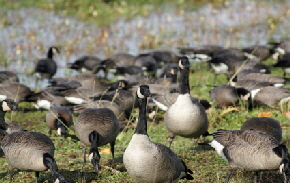Understanding Geese
Resident Canada Geese Biology
Resident geese, as their name implies, spend most of their lives in one area, although some travel hundreds of miles to wintering areas. Resident geese are distinct from the migratory population that nest in northern Canada. Banding studies have shown that resident geese have a strong tendency to return to where they where born and use the same nesting sites year after year. This makes it hard to eliminate geese once they become settled on your golf course or property.
Because of their association with non-hunted locations in urban areas, resident geese have a low exposure to hunting in the fall, and have a higher survival relative to migrant geese. The result is that they live longer; 15-20 year old resident geese are common. They also tend to breed earlier in life and lay larger clutches of eggs and nest in a more hospitable environment, than migrant geese.
Most resident geese begin breeding when they are 2-3 years old and they nest every year for the rest of their lives. Geese lay an average of 5 eggs per nest and about half will hatch and become free-flying birds in the fall. A female goose may produce more than 50 young over her lifetime.
Adult pairs begin returning to nesting areas in late March and as late as mid June, with the peak hatching in May and early June. Geese will aggressively defend their nests and may attack if approached. After hatching, families may move considerable distances from nesting area to a brood-rearing area, appearing suddenly out of nowhere at ponds bordered with grass.
After nesting, geese undergo an annual feather molt, a 4-6 week flightless period when they shed and re-grow their outer wing feathers. Molting occurs between mid June and late July, then birds resume flight in August. During the molt, geese congregate on ponds or lakes that provide a safe place to rest, feed and escape danger. Severe problems often occur at this time of the year because the geese concentrate on greens, tee-offs and fairways next to water.
After the molt is through, the fall geese generally increase the distance of their feeding flights and are more likely to be found away from the water, grazing the grass on a different area of your property.

